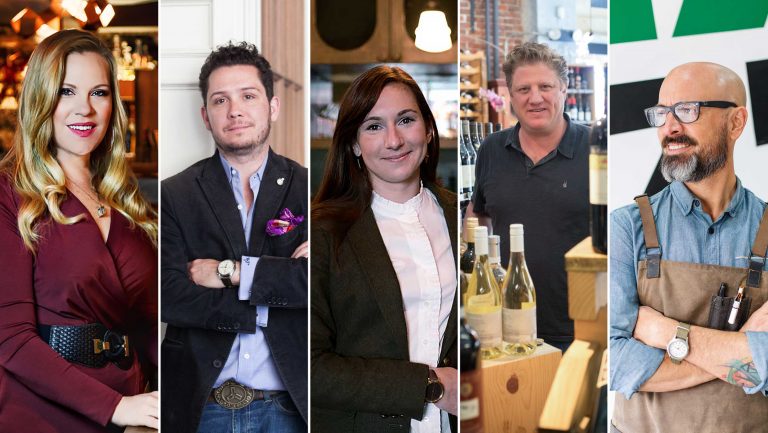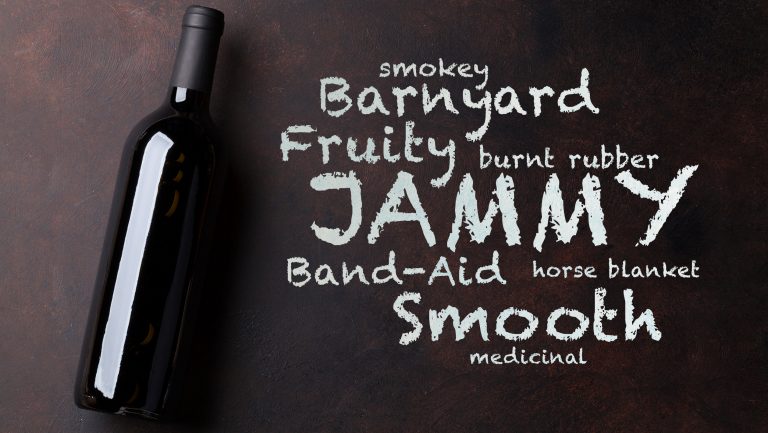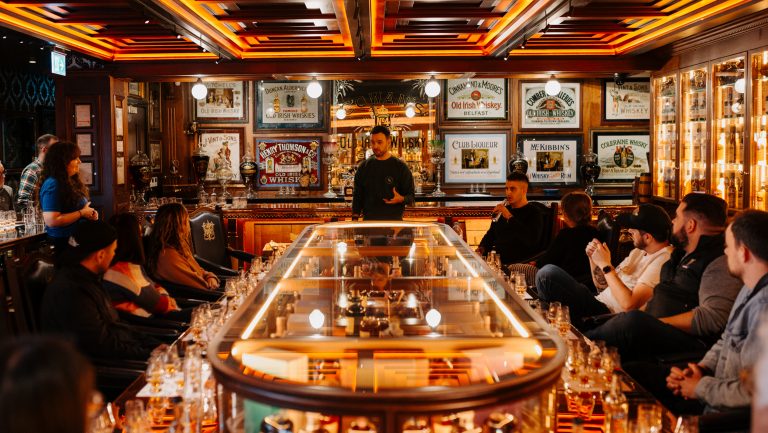As we find ourselves entering another season in this brave new world of virtual tasting, sidling up to our computer screens instead of a barstool for a cocktail, it’s time to revisit our vocabulary and reconsider the words we use when we interact with our customers. Yes, I’m talking about reintroducing words that bartenders and sommeliers are not supposed to say: those cringe-inducing descriptors such as jammy and smooth.
When I made the switch from working at a neighborhood bar to a more formal, fine-dining style of service, I was encouraged to break some habits. For example, pointing is rude; it’s always better to gesture with an open hand. A number of words were also deemed off-limits. Wine shouldn’t be described as fruity or jammy—that’s unsophisticated. I removed the designated taboo adjectives from my vocabulary and replaced them with new, professional-sounding wine and spirits descriptors like phenolic and lactic.
With my elevated vocabulary came some unintended consequences, which placed a subtle wedge between me and my customers. It was something I didn’t notice as a bartender. Using that language was all part of the theater. If I thought my customers didn’t understand, or if they were reluctant to try something new, I could just pour them a little taste, push it in front of them, and have them see exactly what I meant when I said “oxidizative.” It was that little cheat, the ability to let a customer taste something, that made all the difference.

Don’t miss the latest drinks industry news and insights. Sign up for our award-winning newsletters and get insider intel, resources, and trends delivered to your inbox every week.
Things were different when I switched to retail. When I started working at Cask, a San Francisco Bay Area spirits and wine shop that focused on whiskey and single barrel expressions, my customer base expanded. I found myself serving not just cocktail enthusiasts but also customers who needed help buying gifts for their friends and bosses and didn’t necessarily know the lingo (and, frankly, weren’t interested in learning it).
In a retail store—like the virtual world—all you have are your words. That’s when I started to really pick up on my customers’ blank stares and uncertain nods when I tossed out a word like “reductive” to describe a Chablis. Language is our tool to communicate, and I was not using it to its full potential.

5 Descriptors Wine Professionals Avoid
How sommeliers adapt the language of wine to better serve their customers
Elite wine bars and bespoke cocktail joints have developed a bit of a reputation for snootery (totally a real word), the collateral damage of a movement toward encouraging people to drink better cocktails, wines, and spirits. But as many of us find ourselves working, learning, and living in virtual spaces, now more than ever, we should focus on our relationships with people. In our new normal, we host tastings, distillery tours, cocktail classes, and happy hours remotely. In some ways, we have access to the entire world—but only if we speak the right language.
I’m not saying we should use these words all the time or in every encounter; after all, they ended up on the naughty list due to overuse. I’m simply suggesting that we read the room. Using words that actually mean something to the customer can remove unseen barriers.
Whether we’re behind the bar (when they open again), on the sales floor, or in a Zoom cocktail hour, our job in the world of wine and spirits should always be to welcome warmly and educate.
“With my elevated vocabulary came some unintended consequences, which placed a subtle wedge between me and my customers.”
Here are five of the words that are worth reconsidering simply because they instantly make sense to most customers.
Jammy
Jammy is the very first word I was taught to edit out of my vocabulary. It’s considered too basic and assumed to refer to wines that are overly ripe, alcoholic, and lack structure. Sure, wines that we might describe this way often tend to be higher in alcohol and very fruit forward. But jammy doesn’t automatically equate to a poorly made wine. A California Zinfandel or Syrah could earn this descriptor, even if it has good structure. You could argue that it would apply to Châteauneuf-du-Pape. Although this word may be shunned by much of the wine community, I’ve found that consumers usually respond to the adjective favorably.
Fruity
Fruity is jammy’s cousin, and it’s also considered oversimplified in its description. Try putting fruity down as a tasting note with any sommelier and he or she will be quick to ask, But what kind of fruit? Say “apple” and the grilling will continue. What kind of apple? A tart Granny Smith or a ripe Red Delicious? Fresh and crisp or baked in a pie? Relentless! Fruity can be vague, yet customers react positively to the word. It signals that the wine will be approachable, easy to drink, and probably won’t need to open up in a decanter for three hours.
Band-Aid
I absolutely understand why professionals are eager to abandon this word in conversations with customers. But let me tell you, if I say something smells or tastes like a Band-Aid, you know exactly what I’m talking about. With the growing popularity of heavily peated whisky, the reference resonates with many consumers who’ve had occasion to hold their noses over a dram of Laphroaig. Depending on your audience, Band-Aid can be used as either a warning (hey, this whiskey isn’t for everyone!) or a beacon.
In general, I don’t advocate using Band-Aid, but it’s a word I sometimes deploy when I’ve established that someone will be receptive to the smoky, salty, iodine-inflected Scotches from Islay or some of the funky, nontraditional tasting rums of Jamaica, such as Hampden Estate.
Phenolic would be the politest way to describe these spirits, but that word just doesn’t mean anything to most people and can create more confusion.
Barnyard
Horse blanket. A touch of chicken coop. Although professionals often use barnyard, I’ve found that employing it with diners in a restaurant environment is usually discouraged because, well, it conjures something very unpleasant. Often, the descriptor indicates the presence of the yeast Brettanomyces (Brett), and customers who are fans of sour ales will know exactly what you’re talking about. In wine, the flavor profile can be seen as more of a flaw, though not necessarily for fans of old Bordeaux or many natural wines. Again, it all depends on your audience, so use the word at your own risk.
Smooth
I have to admit that I still love to hate this word a little bit. It’s nebulous and completely subjective. But I have been in numerous customer encounters where I’ve exhausted round, velvety, polished, and oily, and I’m still met with blank stares. I find that smooth really resonates for customers in the spirits world, particularly with folks who are new to whiskey.
Sometimes customers will straight up ask, “But is it smooth?” In my vest-wearing bartender days, I might have given them a short lecture on how smooth doesn’t really mean anything. But if a customer is requesting a smooth whiskey, you should probably not send them home with a barrel-proof bourbon such as those prized bottles from Kentucky’s Willett Distillery. Smooth is not a flavor profile, but it can be used to describe the taster’s experience. It’s about texture, heat (or lack of), and approachability.
Ultimately, I’m just someone who wants to put a good bottle of booze in my customers’ hands—something they’ll enjoy no matter which words I have to use to make that happen.

Dispatch
Sign up for our award-winning newsletter
Don’t miss the latest drinks industry news and insights—delivered to your inbox every week.
Nat Harry is a cocktail and spirits professional with 15 years of experience in the beverage industry, including specialty coffee. They spent the last four years curating the spirits portfolio at San Francisco’s Cask stores. A career bartender, Nat fell in love with artisan spirits while running a farm to table bar program at Berkeley’s Revival Bar & Kitchen, and has received accolades including the East Bay Express award for Best Bartender in the East Bay. Nat received SevenFifty Daily’s San Francisco Rising Star award in 2019 and was a judge at this year’s SF World Spirits Competition.







